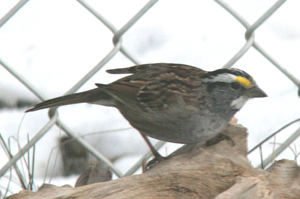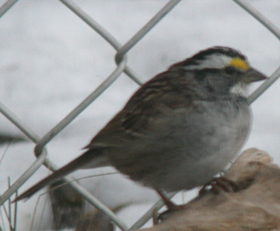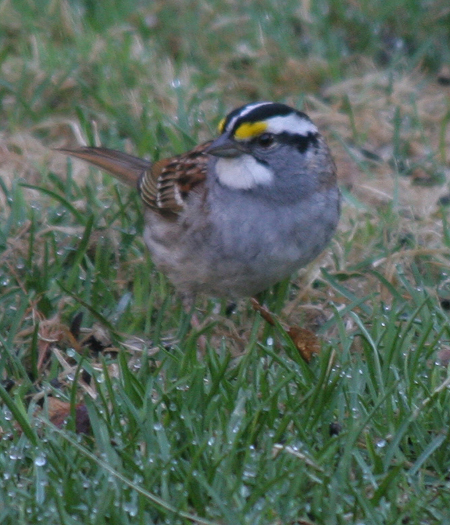White-throated Sparrow
General:
White-throated sparrows are fairly common species. They are fairly abundant and their range is substantial. Compared to many migratory bird populations white-throated sparrow numbers appear to be comparatively stable.
 The White-throated Sparrow The White-throated Sparrow comes in two color forms: white-crowned and tan-crowned. What is interesting is that individuals almost always mate with a bird of the opposite coloration. Additionally, both male and female white-stripe birds are more aggressive than the tan-stripe birds.
The White-throated Sparrow The White-throated Sparrow comes in two color forms: white-crowned and tan-crowned. What is interesting is that individuals almost always mate with a bird of the opposite coloration. Additionally, both male and female white-stripe birds are more aggressive than the tan-stripe birds.
Wh ite-throated sparrows nest either on the ground under shrubs or low in trees. Their eggs are approximately .7″ and are pale-green flecked with brown. The chicks hatch in about 11 – 14 days and fledge in 7 – 12 days. The White-throated Sparrow The White-throated Sparrow and the Dark-eyed Junco occasionally mate and produce hybrids.
ite-throated sparrows nest either on the ground under shrubs or low in trees. Their eggs are approximately .7″ and are pale-green flecked with brown. The chicks hatch in about 11 – 14 days and fledge in 7 – 12 days. The White-throated Sparrow The White-throated Sparrow and the Dark-eyed Junco occasionally mate and produce hybrids.
Identification:
The White-throated Sparrow is a large, full-bodied sparrow, roughly 6″ – 7″, with a fairly prominent bill, rounded head, long legs, and long, narrow tail.
White-throated Sparrows are brown above and gray below with a striking head pattern. They have a black-and-white-striped head and a bright white throat and yellow between the eye and the gray bill.
Habitat:
Woodlands, forest edges, residential areas, shelterbelts In the northeastern U.S. and across most of Canada, white-throated sparrows breed in semi-open coniferous and mixed forests that are regenerating following logging, fires, or insect damage, and where secondary growth provides a low, dense understory.
white_throated_Sparrow
 Territory: Found in their summer range from Alaska to Newfoundland, New England, the Great Lakes Region, and much of Canada. It migrates in the southeastern third of the United States.
Territory: Found in their summer range from Alaska to Newfoundland, New England, the Great Lakes Region, and much of Canada. It migrates in the southeastern third of the United States.
Food:
They mainly eat seeds, insects and berries. They are frequent visitors to bird feeders and can be seen on the ground searching for seeds that have fallen.
Credits:
Patuxent Bird Identification InfoCenter
The Audubon Society – Field Guide to North American Birds (Eastern Region)
Wikipedia, the free encyclopedia
Cornell Lab of Ornithology